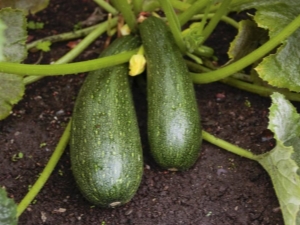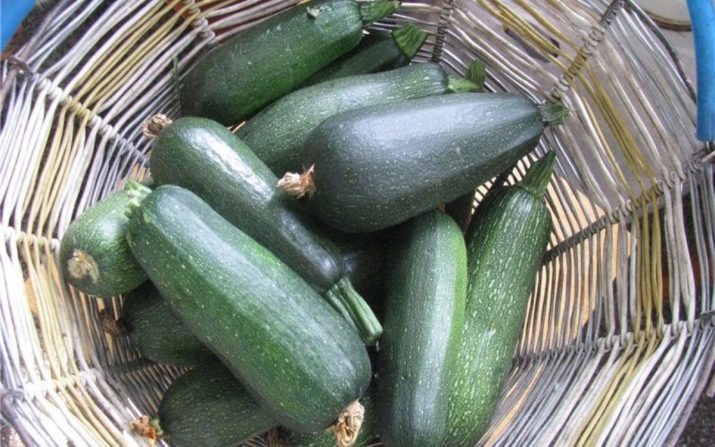Squash squash: variety and agrotechnical features

Zucchini has long been a permanent inhabitant of Russian vegetable gardens. Their fruits differ in large size, ripen quickly and can be eaten without heat treatment. A striking example of such a culture is the squash squash.
Special features
This squash belongs to the early ripening group, by 50 days after the emergence of shoots (on average), technological ripeness is achieved. Ovaries appear quite a lot. Fruits have a cylinder configuration, the edges on them are, but not too pronounced. Courgettes covered with dark green peel, on which white spots are clearly visible. In length, the fruit grows up to 250 mm, the mass can vary from 500 to 1200 g.
The flesh is always juicy and white, its consistency is suitable for producing a variety of dishes. "Skvorushka" is good both in canned and raw. But without heat treatment, it is best to eat fruits no longer than 150 mm and not heavier than 200 g. It is such that they are distinguished by tenderness and juiciness.
How to plant and grow?
Growing zucchini does not present much difficulty. The description of this variety indicates that it is well going through and significant temperature fluctuations, and even dry periods. But even more valuable is that the fruits grow quickly and almost synchronously. The yield is very decent, on 1 square. m can account for up to 10 kg of fruit. To transport the harvest will be obtained without any risk. But the storage of zucchini is difficult because of their thinned skin, it is better to use or recycle collected quickly.
For full growth requires the use of solar space, characterized by a neutral acid reaction of the soil. Liming helps to reduce excess acidity. Fertilizer provides additional support to the plants, introduced several months before planting in the fall. It would be best if this place had previously grown:
- tomatoes;
- potato;
- bow.
If the zucchini is planted with seedlings, it is required to begin preparation in the second month of spring. And when planting seeds directly into the ground is used, one has to wait for the completion of frosts (usually in the last days of May and in the first part of June). Several seeds are placed in the wells at once in each, with the release of more than one sprout leaving only the strongest shoot. Between bushes is required to allocate a place of 0.6 m. This distance does not depend on the method of growing seeds or seedlings.
Reviews and Tips
Judging by the consumer assessment, claims for the care of plants are minimal. Be sure to need a systematic watering, while excessive moisture is not allowed. To loosen and spud zucchini of this variety is required regularly, this affects the development very well. The negative experience of a part of gardeners shows that it is impossible to introduce any dressings without dilution and in exaggerated quantities. Those who strictly adhere to agricultural technology, get an excellent result.
We need to squash the zucchini only with a small growth of the bushes, then the plants themselves “clog” the weeds. Productivity is consistent with the promises of breeders, as well as the quality of the fruit. Farmers especially praise the compactness of the bushes. But at the same time, they note in their responses that, under very favorable conditions, they develop too quickly. The largest diameter of the plant is 1 m, the culture feels good both in free and greenhouse earth.
Reviews of vegetable growers about varieties squash "Skvorushka", see the following video.
Additional recommendations
In addition to the already mentioned crops, root crops and early-ripening vegetables will also be good predecessors for the Skvorushka.
It should take into account the risk of pollination of plants in other varieties in the selection of neighbors.
Almost everywhere, the zucchini of this variety ripens before other species. You can calmly collect overgrown normal fruit, they will retain excellent taste. Remove ripe fruit preferably once every 2 or 3 days.
Since the seeds are initially treated with protective agents, they cannot be soaked. Before planting seeds in the ground should be kept in a damp cloth for several days. Seedlings are prepared in peat pots. Hardening begins 7 days before transfer to the free ground.
The best results are achieved on light soil with a deep location of groundwater.Sandy land is improved by the addition of humus, and clay - by its mixture with sand. Immediately before planting, it makes sense to put 60 g of organic matter in the wells (for example, ash). It is recommended to plant squash squash and other zucchini varieties only on cloudy days or hours.
The big plus is that the variety is not guaranteed to be infected with anthracnose and powdery mildew.


























